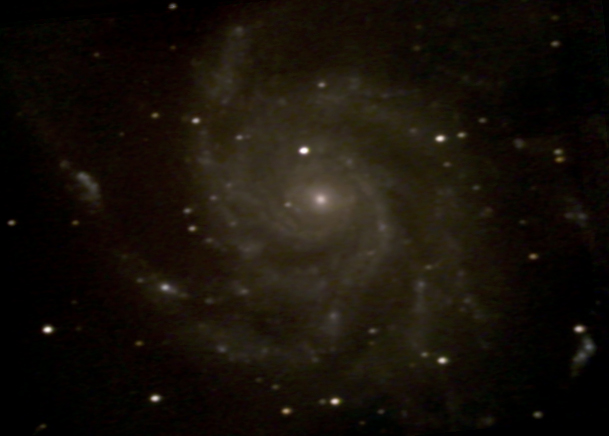
M101

RA: 14hrs 3min 12secs Dec: 54º 21' 00" Mag: 7.9 Distance: 27 million light years Constellation: Ursa major
This is another galaxy discovered by Méchain in 1781. M101 covers as much sky as the full moon, yet proves to be an extremely elusive object to observe, even with a moderate sized telescope (200mm). A type Sc spiral galaxy face-on, it's surface luminosity is much less than its collective magnitude of 7.9 would suggest. As a consequence, its spiral arms are practically impossible to see if there is even the slightest light-pollution. Without the long-exposure of a CCD, I would never be able to see this even with my 8" SCT in the light skies of southern England. M101 is interesting by virtue of the fact that it has star-clouds and fuzzy 'knots' in its spiral arms indicating the presence of HII regions.
This photo was taken on 2 nights, the 2nd and 3rd of June 2006 with the moon in its first quarter and a shroud of thin wispy high cloud passing overhead at regular intervals. The outside temperature was 13.3 deg C. This photograph is the product of 5 stacks, each made up of 30 second exposure additions in Envisage as follows: (40x30sec, 11x, 13x, 14x and 75x) making a cumulative exposure time of 1hr 6.5min. If you have noticed the exposure times of all my previous photographs, it would be immediately obvious that the 5th photo to be stacked was a single 37.5 minute exposure (75x30 seconds). Yes, thanks to a suggestion by Scott Roberts of Meade Inc. regarding drift-aligning my scope PRIOR to 2-star alignment, I have now solved the vertical-drift problem which has plagued all my previous attempts at very long exposures hitherto.
The main challenge of processing this picture was to improve the 'noisy' background - a consequence of the light pollution from a quarter moon, and Abingdon lights. 2 layer masks were created, one in positive and darkened, to block out the sky background during midtone enhancement, and the second in negative, where the sky was whitened leaving only the stars, etc to block them during midtone enhancement to prevent 'star-bloom'. Some compensation had to be made for the colour balance because there was a red-green cast throughout the picture, so the red channel was reduced and the blue increased individually in the levels command. Clearly, the signal-to-noise ratio of this picture leaves much to be desired but as a first attempt, I didn't feel the picture was too bad. I shall, doubtless, be revisiting this object again and again in the years to come.
HOME PICTURES: Deep Sky PICTURES: Solar system PICTURES: Wide field